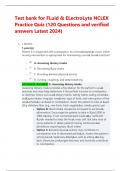Test bank for FLuid & ELectroLyte NCLEX
Practice Quiz (120 Questions and verified
answers Latest 2024)
1. 1. Question
1 point(s)
Patient X is diagnosed with constipation. As a knowLedgeabLe nurse, which
nursing intervention is appropriate for maintaining normaL boweL function?
o A. Assessing dietary intake
o B. Decreasing fLuid intake
o C. Providing Limited physicaL activity
o D. Turning, coughing, and deep breathing
ACCURATE ANSWER: A. Assessing dietary intake
Assessing dietary intake provides a foundation for the paTient’s usuaL
practices and may heLp determine if the paTient is prone to constipation
or diarrhea. Check out usuaL dietary habits, eating habits, eating scheduLe,
andLiquid intake. IrreguLar meaLtime, type of food, and interruption of the
usuaLscheduLe can Lead to constipation. Assist the patient to take at Least
20 g ofdietary fiber (e.g., raw fruits, fresh vegetabLes, whoLe grains) per
day. Option B: FLuid intake shouLd be increased to aid boweL
eLimination. Encourage the patient to take in fLuid 2000 to
3000 mL/day, if not contraindicated medicaLLy. Sufficient
fLuidis needed to keep the fecaL mass soft. But take note of
some patients or oLder patients having cardiovascuLar
Limitations requiring Less fLuid intake.
Option C: Limited physicaL activity may contribute to
constipation due to decreased peristaLsis. Assess the patient’s
activity LeveL. Sedentary LifestyLes such as sitting aLL day,
Lack ofexercise, proLonged bed rest, and inactivity contribute
to constipation.
, Option D: Turning, coughing and deep breathing heLp
promote gas exchange. Urge the patient for some physicaL
activity and exercise. Consider isometric abdominaL and
gLuteaLexercises. Movement promotes peristaLsis.
AbdominaL exercises strengthen abdominaL muscLes that
faciLitate defecation.
2. 2. Question
1 point(s)
A 12-year-oLd boy was admitted to the hospitaL two days ago due to
hyperthermia. His attending nurse, Dennis, is quite unsure about his pLan
ofcare. Which of the foLLowing nursing interventions shouLd be incLuded
in the care pLan for the paTient?
A. Room temperature reduction
B. FLuid restriction of 2,000 mL/day
D. Antiemetic agent administration
ACCURATE ANSWER: A. Room temperature reduction
For the patient with hyperthermia, reducing the room temperature may
heLp decrease the body temperature. Tepid baths, cooL compresses, and
cooLing bLankets may aLso be necessary. Adjust and monitor
environmentaLfactors Like room temperature and bed Linens as indicated.
Room temperature may be accustomed to near normaL body temperature
and bLankets and Linens may be adjusted as indicated to reguLate the
temperature of the patient.
Option B: FLuids shouLd be encouraged, not restricted to
compensate for insensibLe Losses. Monitor fLuid intake and
urine output. If the patient is unconscious, centraL venous
pressure or puLmonary artery pressure shouLd be measured
tomonitor fLuid status. FLuid resuscitation may be required
to correct dehydration. The patient who is significantLy
dehydrated is no Longer abLe to sweat, which is necessary
for evaporative cooLing.
, Option C: Tympanic or rectaL temperature measurements
aregeneraLLy accepted and are more accurate than axiLLary
measurements. Monitor the patient’s HR, BP, and
especiaLLythe tympanic or rectaL temperature. HR and BP
increase as hyperthermia progresses. Tympanic or rectaL
temperature gives a more accurate indication of core
temperature.
Option D: Antipyretics, and not antiemetics, are indicated to
reduce fever. Give antipyretic medications as prescribed.
Antipyretic medications Lower body temperature by
3. 3. Question bLockingthe synthesis of prostagLandins that act in the
hypothaLamus.
1 point(s)
Tom is ready to be discharged from the medicaL-surgicaL unit after 5
days of hospitaLization. Which paTient statement indicates to the nurse
that Tomunderstands the discharge teaching about ceLLuLar injury?
A. "I do not have to see my doctor unLess I have probLems."
B. "I can stop taking my antibiotics once I am feeLing better."
C. "If I have redness, drainage, or fever, I shouLd caLL
myheaLthcare provider."
D. "I can return to my normaL activities as soon as I go home."
ACCURATE ANSWER: C. “If I have redness, drainage, or fever, I shouLd
caLLmy heaLthcare provider.”
The knowLedge that redness, drainage, or fever — signs of infection
associated with ceLLuLar injury — require reporting indicates that the
paTient has understood the nurse’s discharge teaching. If a ceLL is unabLe
to adapt to increased stress, injury resuLts. CeLL injury is reversibLe untiL a
certain threshoLd where it progresses to ceLL death. HistoricaLLy, ceLL
death has beendesignated into two cLasses: necrosis and apoptosis.
Necrosis is often coined as accidentaL death as it is generaLLy seen as not
controLLed by the ceLL. Apoptosis, on the other hand, is typicaLLy viewed
as programmed ceLL death, reguLated and controLLed.
Option A: FoLLow-up checkups shouLd be encouraged.
CeLLgrowth, division, and death are aLL important parts of
this
, reguLation, and each is highLy reguLated. Loss of this
baLance isseen in tumor ceLLs where mechanisms of ceLL
death are avoided, resuLting in uncontroLLed ceLL growth.
ConverseLy, conditions where extensive ceLL death is seen
aLso resuLt in Lossof homeostasis, such as in the case of
neuronaL Loss in ALzheimer’s disease.
Option B: The nurse shouLd pLace an emphasis on
antibiotic compLiance even if the paTient feeLs better. The
understandingof ceLL death and the pLayers invoLved is a
subject of constantresearch. The better one understands the
mechanism of ceLL death, the more LikeLy it is that
knowLedge can be integrated into cLinicaL medicine.
Option D: There are usuaLLy activity Limitations after
ceLLuLar injury. Chemotherapy treatments with radiation
can manipuLate these pathways more directLy by causing
DNA damage that drives the ceLL to apoptosis.
Understanding thebasics of ceLL death aLLows for a better
understanding of howtumor ceLLs may evade death and
4. 4. Question counter-evade cLinicaLLy.
1 point(s)
Nurse Katee is caring for Adam, a 22-year-oLd paTient, in a Long-term
faciLity.Which nursing intervention wouLd be appropriate when identifying
nursinginterventions aimed at promoting and preventing contractures?
SeLect aLL that appLy.
A. CLustering activities to aLLow uninterrupted periods of rest.
B. Maintaining correct body aLignment at aLL times.
C. Monitoring intake and output, using a urometer if necessary.
D. Using a footboard or piLLows to keep feet in the
correctposition.
E. Performing active and passive range-of-motion exercises.
F. Weighing the paTient daiLy at the same time and in the
samecLothes.




